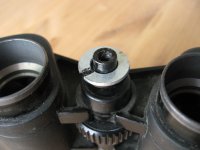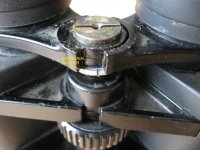christophe17
Member
Hi ! I was looking for a cheap pair of 8x40 that would stand on my office desk just in front the bird feeders, and ocasionnaly do some stars in the backyard. I've been tempted with older Minoltas because of some good reviews and because I used to love my old X700 camera. These can be found quite easily here in France for 20 to 50 euros.
The Minolta range is a real mess, with Standard, Standard ez, Classic I, II and III models and so on, and little reliable data can be found. I bought a MIJ 8x40 MK Standard Extra wide 9.5 °. They're quite robust, and rather heavy at 860 g. I found the centre sharpness and brightness at daytime to be on par with my Bushnell BOL custom 10x50. The sweet spot is wide enough. I didn't measure the FOV but it seems wide. The depth of view is good to, and saves you from constant re-focusing. A good buy overall, but with two drawbacks. First, a distinct yellowish tint. Second, a close focus distance of .... 10 meters ! OMG, 10 meters, when the feeders are 8 meters away from my window ! I could hear the bin gods laughing at me in the heavens.
So I've been thinking of a way to make the close focus distance closer. To make a long story short, the easiest way seemed to set the oculars further away from the body when at minimum focusing. I did it by adding a washer under the bridge ( see pics ). I had to cut the washer for one ocular arm has a small pin that must sit in the slot. The washer is about 2 mm thick and this gives me now an acceptable 5 m close focus. A thicker washer would have been even better but some problems would have resulted. First, the ocular sleeves may have been too short, second, the sloted brass tightening nut that keeps both arms of the bridge together ( see pic ) may have been too short as well.
Now I have enough close focus to look at the feeders, without loosing the infinity focus. Unfortunately, I've no solution for the yellowish tint...
Hope this can be useful, and let the spirit of Porro be with you.
The Minolta range is a real mess, with Standard, Standard ez, Classic I, II and III models and so on, and little reliable data can be found. I bought a MIJ 8x40 MK Standard Extra wide 9.5 °. They're quite robust, and rather heavy at 860 g. I found the centre sharpness and brightness at daytime to be on par with my Bushnell BOL custom 10x50. The sweet spot is wide enough. I didn't measure the FOV but it seems wide. The depth of view is good to, and saves you from constant re-focusing. A good buy overall, but with two drawbacks. First, a distinct yellowish tint. Second, a close focus distance of .... 10 meters ! OMG, 10 meters, when the feeders are 8 meters away from my window ! I could hear the bin gods laughing at me in the heavens.
So I've been thinking of a way to make the close focus distance closer. To make a long story short, the easiest way seemed to set the oculars further away from the body when at minimum focusing. I did it by adding a washer under the bridge ( see pics ). I had to cut the washer for one ocular arm has a small pin that must sit in the slot. The washer is about 2 mm thick and this gives me now an acceptable 5 m close focus. A thicker washer would have been even better but some problems would have resulted. First, the ocular sleeves may have been too short, second, the sloted brass tightening nut that keeps both arms of the bridge together ( see pic ) may have been too short as well.
Now I have enough close focus to look at the feeders, without loosing the infinity focus. Unfortunately, I've no solution for the yellowish tint...
Hope this can be useful, and let the spirit of Porro be with you.





